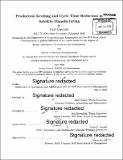| dc.contributor.advisor | Kerri Cahoy and Don Rosenfield. | en_US |
| dc.contributor.author | Gantner, Karl (Karl Andrew) | en_US |
| dc.contributor.other | Leaders for Global Operations Program. | en_US |
| dc.date.accessioned | 2016-09-13T19:13:38Z | |
| dc.date.available | 2016-09-13T19:13:38Z | |
| dc.date.copyright | 2016 | en_US |
| dc.date.issued | 2016 | en_US |
| dc.identifier.uri | http://hdl.handle.net/1721.1/104217 | |
| dc.description | Thesis: S.M., Massachusetts Institute of Technology, Department of Aeronautics and Astronautics, 2016. | en_US |
| dc.description | Thesis: M.B.A., Massachusetts Institute of Technology, Sloan School of Management, 2016. In conjunction with the Leaders for Global Operations Program at MIT. | en_US |
| dc.description | Cataloged from PDF version of thesis. | en_US |
| dc.description | Includes bibliographical references (pages 50-52). | en_US |
| dc.description.abstract | Reducing cycle time for geostationary communication satellites represents a major competitive advantage for manufacturers. Reducing cycle time can be done through application of lean manufacturing techniques such as production leveling, or heijunka. However, research on applying lean manufacturing to the manufacture of satellites is not straightforward as payloads vary considerably. To show the effect of production leveling on satellite manufacturing, we analyze production data recorded over a 5-year time frame from a major satellite manufacturer to propose and simulate a method for leveling production. Statistical analysis of historical cycle times was performed to identify the critical path and bottleneck in the satellite development process. Production through the bottleneck was then leveled at the maximum consistent throughput. The effect of leveling was estimated using a Monte Carlo simulation to predict the total cycle time and delivery date for each satellite. Analysis showed that the critical path ran through the development of the communications payload and the bottleneck was at the payload unit build process. The bottleneck was leveled to operate at a takt time of 2 months with 4 payloads in WIP at a time. Simulating a leveled bottleneck estimated that the total cycle time of each satellite, on average, would decrease by 1.9 months with a standard deviation of 14 days. Cycle time in the payload unit manufacturing process fell from 13 months to 8 months, with standard deviations 64 and 12 days, respectively. Over the 5-year period investigated, all satellites through the factory would have met their delivery dates while being produced to a 2 month takt. These results demonstrate that production leveling can be applied to the high-mix low volume manufacturing of geostationary communications satellites to increase efficiency and reduce cycle time. Leveling manufacturing should be a top priority for all satellite manufacturers looking to become more competitive. | en_US |
| dc.description.statementofresponsibility | by Karl Gantner. | en_US |
| dc.format.extent | 52 pages | en_US |
| dc.language.iso | eng | en_US |
| dc.publisher | Massachusetts Institute of Technology | en_US |
| dc.rights | M.I.T. theses are protected by copyright. They may be viewed from this source for any purpose, but reproduction or distribution in any format is prohibited without written permission. See provided URL for inquiries about permission. | en_US |
| dc.rights.uri | http://dspace.mit.edu/handle/1721.1/7582 | en_US |
| dc.subject | Aeronautics and Astronautics. | en_US |
| dc.subject | Sloan School of Management. | en_US |
| dc.subject | Leaders for Global Operations Program. | en_US |
| dc.title | Production leveling and cycle time reduction in satellite manufacturing | en_US |
| dc.type | Thesis | en_US |
| dc.description.degree | S.M. | en_US |
| dc.description.degree | M.B.A. | en_US |
| dc.contributor.department | Leaders for Global Operations Program at MIT | en_US |
| dc.contributor.department | Massachusetts Institute of Technology. Department of Aeronautics and Astronautics | |
| dc.contributor.department | Sloan School of Management | |
| dc.identifier.oclc | 958140964 | en_US |
